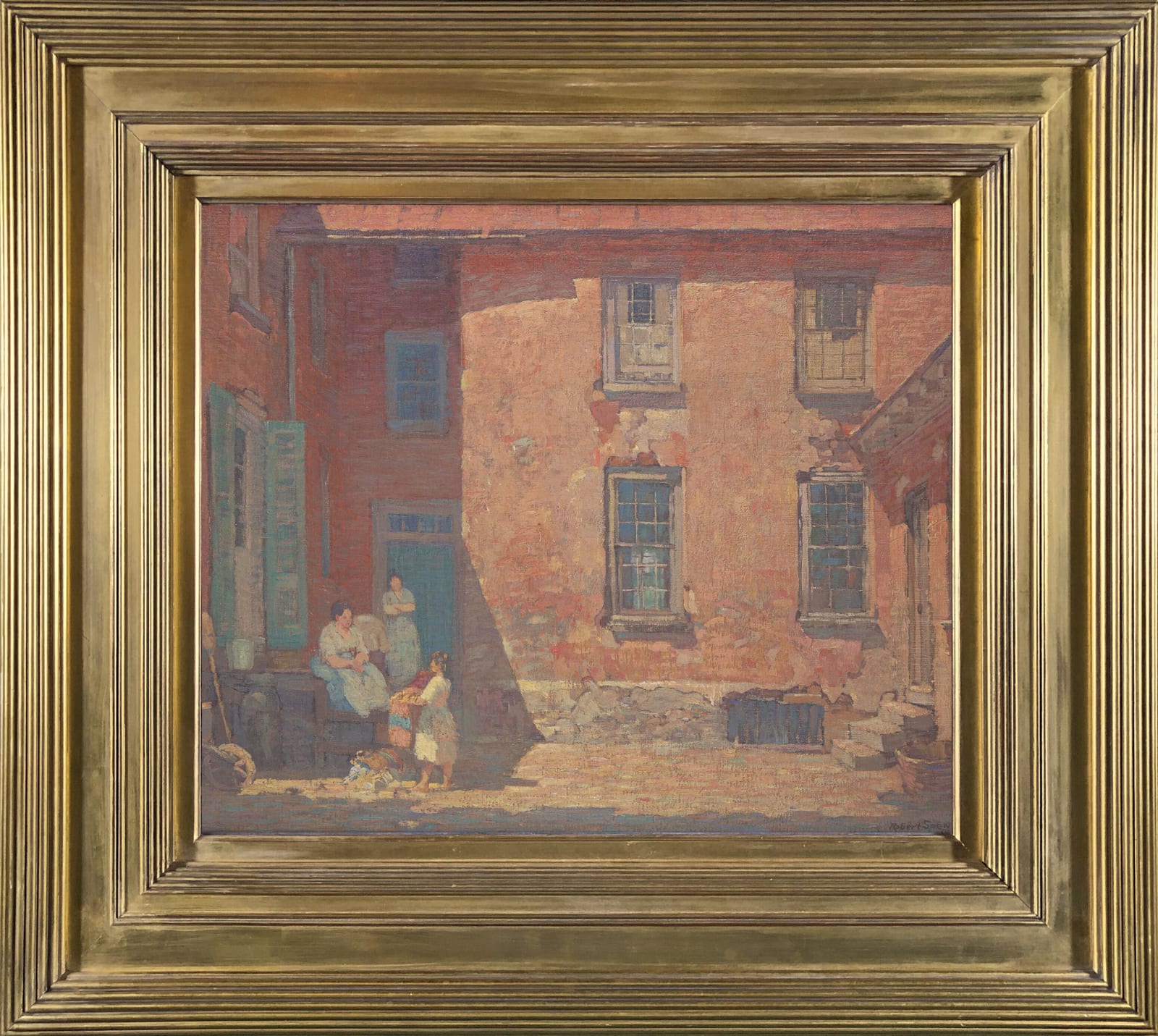Robert Spencer 1879-1931
Courtyard at Noon
Oil on canvas
20 x 24 inches
50.8 x 61 cm
Framed dimensions 31 3/8 x 35 3/8 inches
50.8 x 61 cm
Framed dimensions 31 3/8 x 35 3/8 inches
Signed lower right: Robert Spencer
It is difficult to succinctly characterize Robert Spencer as an artist. He was at once a Pennsylvania Impressionist landscape painter but also in many ways a Realist. Not one to...
It is difficult to succinctly characterize Robert Spencer as an artist. He was at once a Pennsylvania Impressionist landscape painter but also in many ways a Realist. Not one to paint an idealized view of nature, Spencer was more interested in poetically capturing the more mundane aspects of every day life. As his biographer F. Newlin Price wrote, “Although catalogued as a landscapist, Spencer really is a genre painter. It is the intimate, daily, romantic life of the people that he is interested in; never in the political life or in the fashion of the day.” Spencer loved things that were old, beat-up, and abandoned. Rundown mills or tenement houses and the ordinary, working-class people who inhabited them piqued his interest the most.
After spending his early career primarily focused on capturing the region around Bucks County and along the Delaware River, Robert Spencer shifted his attention to other locations. He began to paint New York City's docks and harbors, but also to look farther afield, to Europe, where he depicted its canals, bridges, towns, and houses. Despite its very Italian theme, the present work was likely executed in America, near Bucks County, and before the artist's trip to Europe. It belongs to a series of several canvases (at least three) centered on an open courtyard at various hours of the day, from dawn to dusk, and featuring the daily activities of its inhabitants (see Courtyard at Dusk, 1913; and The Courtyard, circa 1916).
Courtyard at Noon is probably the quietest of the series, as it only features three figures (all women) in the titular courtyard. Gathered in a corner, they appear to enjoy a break from their chores, while the men are likely out working. Executed in a limited palette of salmon pinks, turquoise blues and grey, the work still is charged with the brightness of the midday sun, which conveys a relaxed, and cheerful atmosphere to the scene. The dappled brushwork has a strong impressionistic feel to it, which suggests the artist worked on the spot, quickly before the sun's course moved too quickly. It also echoes the palpable excitement of Spencer, who according to Brian H. Peterson "had fallen in love with a real place that he tried to depict realistically, even though he almost certainly changed elements of the scene to enhance its picturesqueness." Beyond Spencer's painstaking attention to detail in this canvas, the picture also charms by its evident appreciation for the poetry of a modest yet distinctive building, which witnesses the many lives of the people who live there. True to the artist's education at the National Academy of Design, the painting also recalls the many courtyard scenes of 17th century Dutch painter Pieter de Hooch, from whom Spencer seems to have borrowed the vision of a domestic simplicity and tranquility.
After spending his early career primarily focused on capturing the region around Bucks County and along the Delaware River, Robert Spencer shifted his attention to other locations. He began to paint New York City's docks and harbors, but also to look farther afield, to Europe, where he depicted its canals, bridges, towns, and houses. Despite its very Italian theme, the present work was likely executed in America, near Bucks County, and before the artist's trip to Europe. It belongs to a series of several canvases (at least three) centered on an open courtyard at various hours of the day, from dawn to dusk, and featuring the daily activities of its inhabitants (see Courtyard at Dusk, 1913; and The Courtyard, circa 1916).
Courtyard at Noon is probably the quietest of the series, as it only features three figures (all women) in the titular courtyard. Gathered in a corner, they appear to enjoy a break from their chores, while the men are likely out working. Executed in a limited palette of salmon pinks, turquoise blues and grey, the work still is charged with the brightness of the midday sun, which conveys a relaxed, and cheerful atmosphere to the scene. The dappled brushwork has a strong impressionistic feel to it, which suggests the artist worked on the spot, quickly before the sun's course moved too quickly. It also echoes the palpable excitement of Spencer, who according to Brian H. Peterson "had fallen in love with a real place that he tried to depict realistically, even though he almost certainly changed elements of the scene to enhance its picturesqueness." Beyond Spencer's painstaking attention to detail in this canvas, the picture also charms by its evident appreciation for the poetry of a modest yet distinctive building, which witnesses the many lives of the people who live there. True to the artist's education at the National Academy of Design, the painting also recalls the many courtyard scenes of 17th century Dutch painter Pieter de Hooch, from whom Spencer seems to have borrowed the vision of a domestic simplicity and tranquility.
Provenance
Private collection, Michigan;Freeman's, Philadelphia, American Art and Pennsylvania Impressionists Featuring the Collection of Charles and Virginia Bowden, December 4, 2022, lot 104;
Private collection, New York
Please join our mailing list
* denotes required fields
We will process the personal data you have supplied in accordance with our privacy policy (available on request). You can unsubscribe or change your preferences at any time by clicking the link in our emails.



